A Winter Tour today in North Norfolk. After Storm Doris had blown through yesterday (thankfully, with no tours arranged!), bringing gusts of up to 81mph, it was a welcome return to calmer conditions today. It was mostly cloudy, but we did enjoy some nice sunnier intervals later in the afternoon.
Our first stop was at Holkham. As we drove up Lady Anne’s Drive, we could see large flocks of Wigeon still on the grazing marshes. It won’t be too long now before they will start to depart for their Russian breeding grounds.
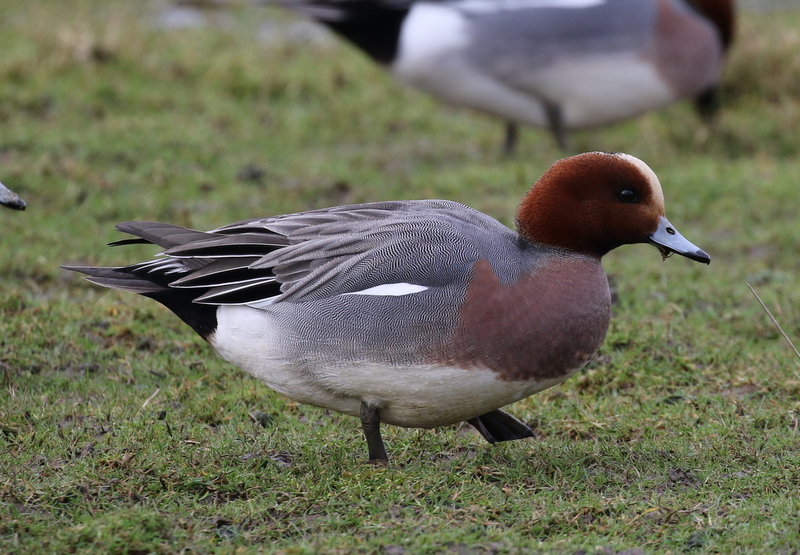 Wigeon – still large flocks on the grazing marshes at Holkham
Wigeon – still large flocks on the grazing marshes at Holkham
Most of the Pink-footed Geese have already departed on their way back north, although they will stop off in northern England or Scotland before continuing on their way to Iceland. However, there are still a few around and we managed to find a small party of Pink-footed Geese further over on the grazing marshes. A quick look through the scope, and we discovered there were a couple of White-fronted Geese with them too and a single Brent Goose.
Walking through the gap in the trees towards the beach, there were lots of small branches and leaves scattered over the path, the remnants of last night’s storm. We made our way east, along the path on the edge of the saltmarsh. Out in the vegetation, we could see a small group of Brent Geese and Shelduck. Most of the geese were Dark-bellied Brents, the commonest subspecies here in winter, they breed in northern Russia. There is also a regular Black Brant hybrid here, the returning progeny of a vagrant Black Brant which had paired up with a Dark-bellied Brent Goose many years ago, this hybrid now comes back every year to the same place.
 Black Brant hybrid – the regular returning bird, still with the Brent flock at Holkham
Black Brant hybrid – the regular returning bird, still with the Brent flock at Holkham
It didn’t take long to find the Black Brant hybrid in with the small flock of Brents. It has a noticeably whiter flank patch and more extensive collar, as well as being a touch darker above and on the belly than the accompanying Dark-bellied Brent Geeese. However, it is not quite dark or contrasting enough to match a pure Black Brant. It is always an interesting bird to see here.
As we walked along, several Meadow Pipits flew up from the saltmarsh, but it wasn’t until we got to the east end that we found the Shorelarks, in their regular spot. They are currently feeding mostly in the slightly taller vegetation, so can be hard to see. Thankfully we were able to find them before some other birders walked right through the area they were hiding.
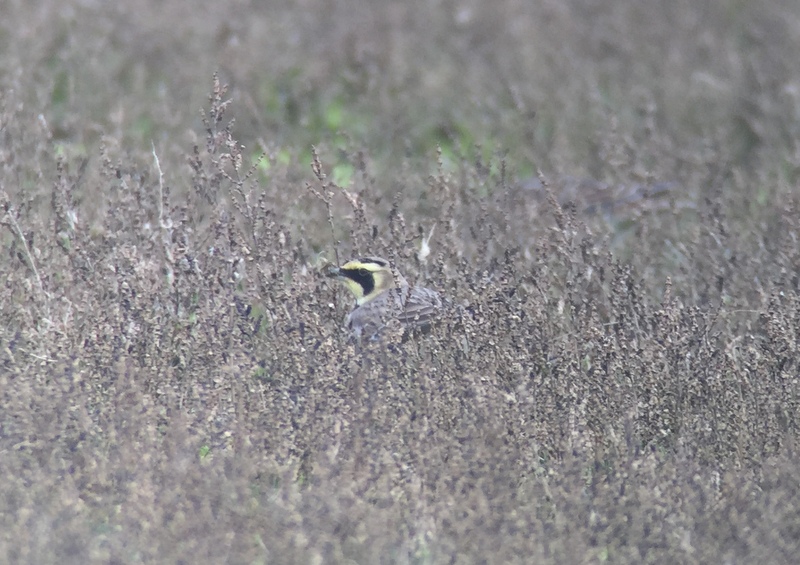 Shorelark – still 29+ here, feeding in the taller vegetation on the saltmarsh
Shorelark – still 29+ here, feeding in the taller vegetation on the saltmarsh
We watched the Shorelarks for a while. At first, it looked like there were only 5-6 of them again, but gradually we spotted more creeping around in the sea lavendar seed heads. With their heads down, they were particularly hard to see, but occasionally a bright yellow face with black bandit mask would pop up out of the vegetation.
When a Common Buzzard drifted out from the pines and across the saltmarsh, the Shorelarks all took off and only at that stage could we see how many there really were. They landed on a slightly more open sandy ridge and a quick count suggested there were 29, although we could easily still have missed one or two. Then they scuttled quickly back into cover.
We walked over to the dunes and had a quick look at the sea. It was still rather rough after yesterday, and there didn’t appear to be a lot visible today. We did find a couple of Red-breasted Mergansers feeding in the breakers. There were also lots of Oystercatchers and gulls on the beach, feeding on shellfish washed up after the storm, and several Sanderling were running in and out of the waves between them.
As we made our way back to Lady Anne’s Drive, a small bird came zipping low across the saltmarsh and out towards the dunes. It was a Merlin. Often that is all you see of them, as they disappear off into the distance, but this one helpfully decided to land on a small Suaeda bush, where we could get a great look at it through the scope. It perched there for several minutes, before flying off over the dunes and away west over the beach. As we got back to the boardwalk, a Sparrowhawk was circling over the pines.
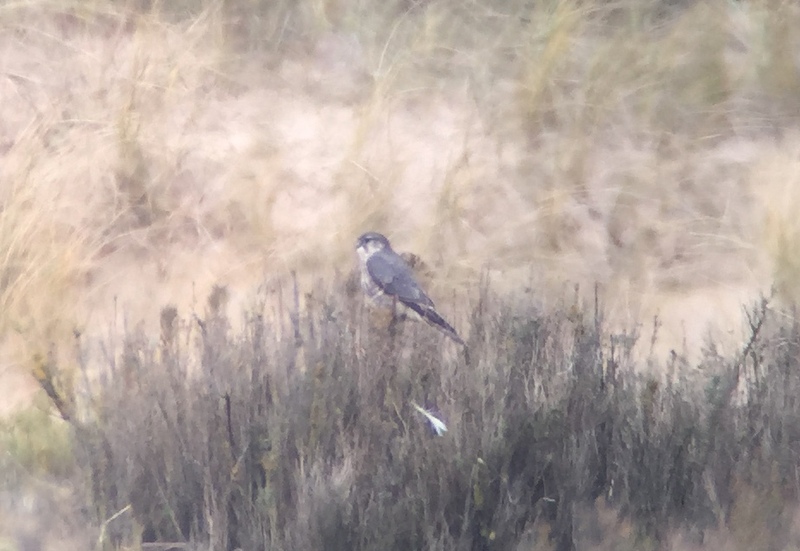 Merlin – perched up for us to get a great look at it
Merlin – perched up for us to get a great look at it
From Lady Anne’s Drive, we walked west on the inland side of the pines. A tree was down across the path and the wardens were in the process of clearing it with chainsaws. Despite the noise, we could hear Goldcrests and Long-tailed Tits in the trees. Further along, a Treecreeper was singing. Salts Hole held a Little Grebe, a pair of Tufted Ducks, plus a few Coot and Wigeon. A Jay flew across, over the back of the water.
As we approached Washington Hide, we saw a Spoonbill fly up briefly, which appeared to drop down again, possibly onto one of the pools. We had a scan of the grazing marshes from the boardwalk by the hide, but couldn’t see it from there. A Marsh Harrier circled up out of the reedbed. Then the Spoonbill flew up again and disappeared off further west.
At Joe Jordan Hide, there didn’t seem to be as much activity as recent days at first. There was a scattering of commoner geese – Greylags, Canada Geese and Egyptian Geese – out on the grass. A small group of White-fronted Geese were feeding on the old fort, but as we sat and watched, a steady stream of small groups flew in and joined them, mostly from the other side of Decoy Wood.
 White-fronted Geese – flying in to land on the grazing marshes
White-fronted Geese – flying in to land on the grazing marshes
A juvenile Peregrine was standing by the edge of one of the pools further over, but took off just as we turned the scope onto it. It proceeded to have a go at most of the other birds in the vicinity, swooping down at ducks and geese, but didn’t really seem to know what it was doing. We also saw several more Marsh Harriers and Common Buzzards from here – it is often a good spot for raptors.
Finally, we managed to find the Spoonbill. It was right out across the other side of the grazing marshes and feeding in a small pool. With its head down, it was impossible to see, but just visible occasionally as it lifted its head up. Thankfully, after a while it flew out and landed on the open grass where we could get a slightly better look at it. It was a juvenile, lacking the yellow bill tip and bushy crest of the adults. There was no sign of the other three Spoonbills today, or any Great White Egrets from here.
Back at Lady Anne’s Drive, we stopped for lunch at the picnic tables over looking the grazing marshes. As well as the Wigeon still, there was a selection of waders out on the grassy pools, including Oystercatcher, Curlew and Redshank. A pair of Mistle Thrushes flew down out of the pines. After lunch, as we drove back towards the coast road, the Pink-footed Geese were now close to Lady Anne’s Drive so we stopped quickly for a better look.
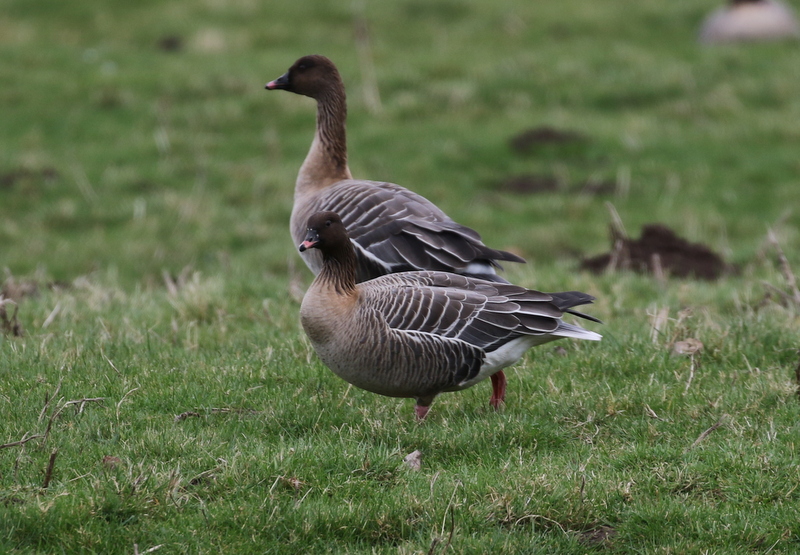 Pink-footed Geese – nice views close to Lady Anne’s Drive after lunch
Pink-footed Geese – nice views close to Lady Anne’s Drive after lunch
From the road, we pulled up to scan the other side of the marshes and quickly spotted a very tall white shape, a Great White Egret. We stopped and got the scope on it. Helpfully, there was a Grey Heron just next to it for comparison and we could see that the Great White Egret was as tall or even slightly taller! The long yellow-orange bill also really stood out.
 Great White Egret – out on the grazing marshes at Holkham
Great White Egret – out on the grazing marshes at Holkham
Scanning across the marshes, we found a second Great White Egret, hiding in a reedy ditch. There were also lots more White-fronted Geese this side, which is why there were not so many visible from Joe Jordan Hide today. Amongst a flock of Lapwings and Starlings down on the wet grass, we found a little group of Ruff too.
As we made our way further west along the coast road, a shout from one of the group alerted us to a Barn Owl perched on a post right beside the road as we drove past. Never an easy place to stop, we managed to reverse back to it. It sat for a few seconds looking at us, but then flew a little further along as another car pulled up behind. Driving forwards very slowly, we were able to watch it only about 10 metres away from us. Stunning views! Eventually, the growing number of cars stopping to look seemed to spur it into action and it flew across the road and started hunting over the marshes.
 Barn Owl – perched on a post right beside the road in the middle of the day
Barn Owl – perched on a post right beside the road in the middle of the day
There has not been as much daytime Barn Owl activity this winter, which may reflect the generally mild and clement conditions we have enjoyed. It they are not hungry, then there is no need for them to hunt during the day. Presumably Storm Doris had made hunting very difficult yesterday and overnight, so this Barn Owl had come out to try to catch something during the day. We could see that it was ringed, but unfortunately couldn’t read the full number from photos. Many wild Barn Owls are ringed in the nest in North Norfolk.
After that unexpected bonus, we continued on to Titchwell, where we planned to spend the rest of the afternoon. The feeders round the visitor centre held a selection of the commoner finches and tits, but no sign of any Brambling today. The Water Rail put on a good show, feeding out in the open in the ditch by the main path, probing in the decaying leaves, seemingly unconcerned by the large lenses pointed at it.
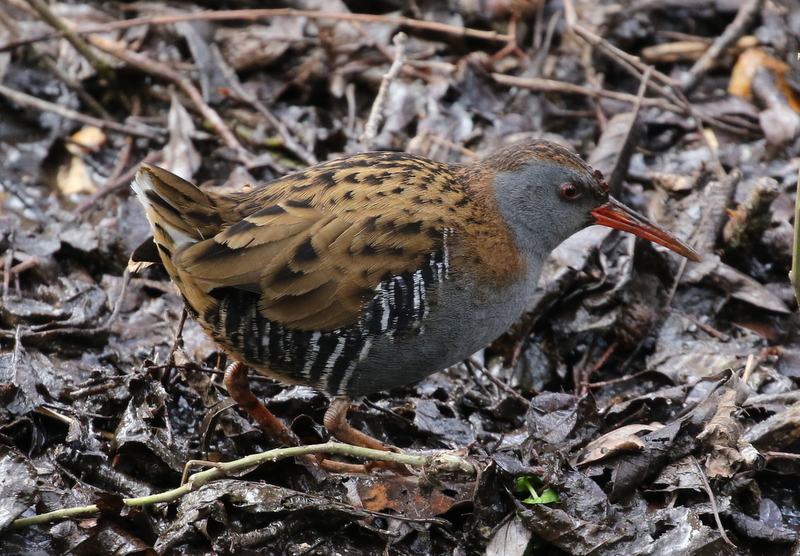 Water Rail – still in the ditch by the path
Water Rail – still in the ditch by the path
The grazing meadow was rather quiet again but the reedbed pool did at least provide Common Pochard as an addition for the day’s list. The water levels on the freshmarsh have been slowly coming down and there was a nice selection of birds on here today.
The first thing that struck us when we arrived was the gulls. There were large numbers of Black-headed Gulls and Common Gulls loafing on the edges of the islands or in the shallow water. In with them were a few Herring Gulls and Lesser Black-backed Gulls. We had a scan through from Island Hide, but it was only from further up that a Mediterranean Gull was visible. It was an adult, with white wing tips and bright red bill, just moulting in to summer plumage, with white speckling still around the front of its jet black hood.
 Mediterranean Gull – an adult moulting into summer plumage
Mediterranean Gull – an adult moulting into summer plumage
There was still the usual variety of ducks on the freshmarsh. The Teal were looking particularly smart, in the afternoon sunshine, just below the path. Further over, we could see a selection of Wigeon, Gadwall, Shoveler and a pair of Pintail. A large flock of Brent Geese flew in from the saltmarsh towards Brancaster, calling noisily, and landed on the water to bathe and preen.
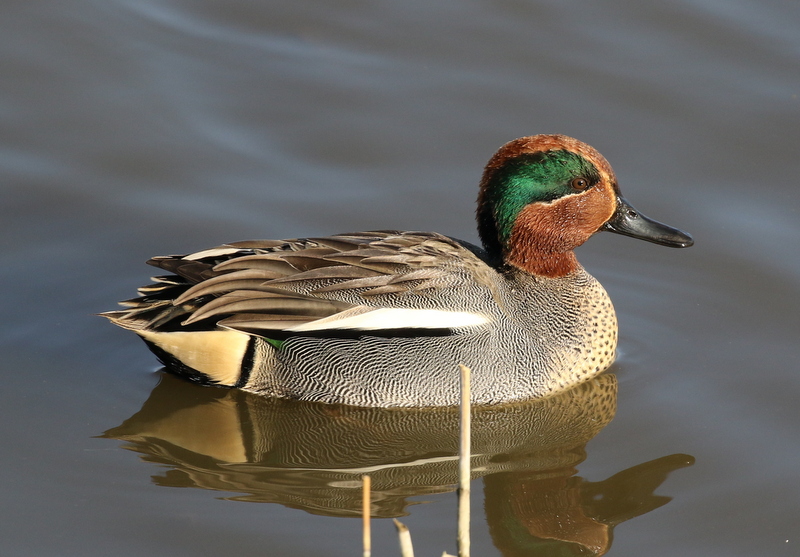 Teal – a smart drake in the sunshine
Teal – a smart drake in the sunshine
Wader numbers on the freshmarsh are increasing now, in particular the number of Avocets, as birds return north. There were also more Black-tailed Godwits today, though mostly sleeping in amongst the gulls. A small group of Dunlin included a single Knot for comparison. Singles of Grey Plover and Turnstone had presumably flown in from the beach ahead of high tide. The fenced off Avocet Island at the back was packed with Golden Plover and Lapwing, with more small flocks of Golden Plover dropping in to join them all the time.
 Curlew – on the Volunteer Marsh
Curlew – on the Volunteer Marsh
There were more waders on the Volunteer Marsh. As well as more Knot, Dunlin and Grey Plover, there were lots of Redshank and Curlew. A single Ringed Plover was a welcome addition to the day’s list. With high tide approaching, more waders were roosting on the Tidal Pools, particularly several Bar-tailed Godwits. This gave us a great opportunity to compare them to a couple of Black-tailed Godwits feeding nearby. Even without seeing their respective tails, the buffier tones, black streaked upperparts, shorter legs and upturned bill all quickly distinguish the Bar-tailed Godwits.
 Avocet – on the Tidal Pools
Avocet – on the Tidal Pools
There were also more Knot and Redshank on the Tidal Pools, and several Avcoets feeding, including one close to the path.
We wanted to have a look at the sea, but there was not as much activity out here as there has been in recent weeks. There was still a big swell running, after the storm yesterday, and several of the ducks appeared to be quiet a way offshore. Fortunately, there was a nice group of about twenty Velvet Scoters close in, diving for shellfish. Several were holding their wings loosely folded, revealing the white wing flash as a stripe on their flanks. The face pattern is rather variable, particularly at this time of year, but it was possible to see the distinctive white spot at the base of the bill on some.
Helpfully, there was also a female Common Scoter with them for comparison, with a very extensive pale cheek and dark cap, and no white wing flash. There were more Common and Velvet Scoters in a larger raft much further out. A female Goldeneye drifted past in front of them, but most of the other Goldeneyes were a long way offshore today. A Fulmar flew past too.
Back at the Tidal Pools, we stopped to look again at a group of roosting waders, particularly with Bar-tailed Godwit and Black-tailed Godwit side by side. But a scan further along revealed that a Spotted Redshank had flown in while we were out at the beach. We walked back and had great views of it feeding in the shallows not far from the path. With a Common Redshank nearby for comparison, we could see that the Spotted Redshank was noticeably paler, more silvery grey above and whiter below, with a longer and finer bill and a better marked, brighter white supercilium.
 Spotted Redshank – had flown in to the Tidal Pools while we were on the beach
Spotted Redshank – had flown in to the Tidal Pools while we were on the beach
As we passed the freshmarsh on our way back, the Golden Plovers and Lapwings all spooked, They took off and whirled round in flocks overhead, the Golden Plovers particularly tight packed. We couldn’t see anything which might have alarmed them, although they had been jumpy all afternoon, and they quickly settled back down again.
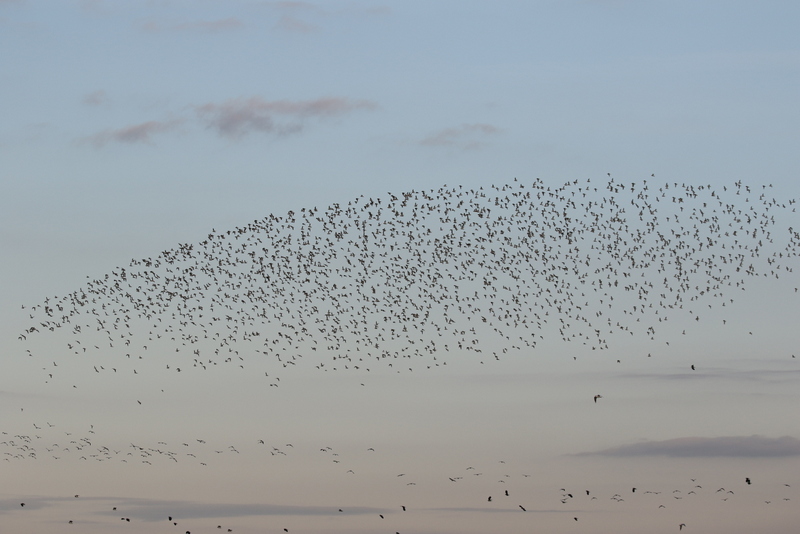 Golden Plovers – whirling around over the freshmarsh
Golden Plovers – whirling around over the freshmarsh
A quick look down along one of the reedy channels in the reedbed revealed a Kingfisher, perched up on a reed along the edge. We had a quick look at it through the scope, before another bird spooked it and it flew off across the reeds. We looked back to see a second Kingfisher had appeared, presumably having chased off the first. Then it was time to call it a day and head for home.
















